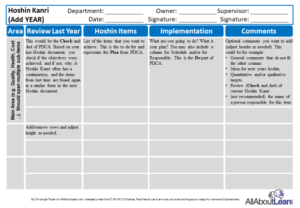 This week I will look at Hoshin Kanri (方針管理, policy management). The word is often used as a sort of miracle cure for the problems in your organization. The tool itself, however, is rather mundane, although it did significantly help Toyota. This, of course, did not stop the West from over-complicating and over-hyping it. This post is the start of a small series on Hoshin Kanri.
This week I will look at Hoshin Kanri (方針管理, policy management). The word is often used as a sort of miracle cure for the problems in your organization. The tool itself, however, is rather mundane, although it did significantly help Toyota. This, of course, did not stop the West from over-complicating and over-hyping it. This post is the start of a small series on Hoshin Kanri.
Introduction
 Hoshin Kanri is a way to organize and prioritize your main objectives. You could see it as a glorified cross between a to-do list and a PDCA (Plan, Do, Check, Act). It is actually well described as a prioritized to-do list and PDCA combination. Please don’t get me wrong, both to-do lists and PDCAs are very, VERY useful tools, and combining them in a Hoshin Kanri makes them even stronger. Just don’t expect any magic out of it.
Hoshin Kanri is a way to organize and prioritize your main objectives. You could see it as a glorified cross between a to-do list and a PDCA (Plan, Do, Check, Act). It is actually well described as a prioritized to-do list and PDCA combination. Please don’t get me wrong, both to-do lists and PDCAs are very, VERY useful tools, and combining them in a Hoshin Kanri makes them even stronger. Just don’t expect any magic out of it.

Hoshin Kanri is sometimes oversold to make it look larger than life. Nobody would do this with a to-do list, as you all know what it is, but Hoshin Kanri has a fancy Japanese name combined with an often limited understanding, making it a suitable word for impressing others.
Hoshin Kanri is a very useful tool, but as with pretty much all lean tools, they only work if they are used. Doing a Hoshin sheet once is not too difficult. Sticking with it, on the other hand, is much harder. Just having the sheet won’t help. This is the same as the fancy home trainer you may have. If you don’t use it, then it is a waste of money. Same with the bread maker that may be sitting in the bottom cabinet of your kitchen (and to all readers who eat homemade bread every day after exercising: Apologies for doubting you, I applaud your rigor).
The (Prioritized) To-Do List
 The first part of Hoshin Kanri is a prioritized list of the things that you want or have to achieve. These are sometimes called Hoshin items. Depending on the environment you are making the Hoshin Kanri for, this may be a list for your own development (a personal Hoshin), or a list based on the goals you get from your superiors.
The first part of Hoshin Kanri is a prioritized list of the things that you want or have to achieve. These are sometimes called Hoshin items. Depending on the environment you are making the Hoshin Kanri for, this may be a list for your own development (a personal Hoshin), or a list based on the goals you get from your superiors.
The important part is to prioritize. What are your most important to-dos that you want on the list. These should be the most relevant to the overall progress or yourself (personal Hoshin) or your company. For example, my wife made me the waste management specialist in our home … meaning I have to bring down the trash … but I would not put this on my personal Hoshin as it is not of significance to my development.

Be careful not to overdo it. There should be only three to six main points (Hoshin items), each of which could include a few sub-points. Less is more here. Do not get lost in too much detail.
Furthermore, these items should be based on a process, not on a target. It would be easy to simply say that your “defect rate has to be below xx part per millions.” However, this would fall short of the potential of Hoshin Kanri. Instead you could try to “strengthen management to implement better countermeasures against repeated problems” or “develop the quality skills of your people.”
Please do not neglect the topics and directions of your Hoshin items. Many other documents and web pages skip over that and focus on the more agreeable roll out across your departments (which we will do later too). However, having the right Hoshin items is crucial. Personally, I found it quite challenging to get good and process-based Hoshin items for my own personal Hoshin, and I am still not sure if they are good.
What Could Be on Your List?
 There are a number of different topics that could be on your list. As mentioned above, these should be limited, and should be focused on the process rather than a target. Below is a list of possible headers under which you could list sub-points. The first list is geared toward a corporate Hoshin, and the second list more toward a personal one. Please do not use all! Less is more here, and focus on the important ones will help you to get them actually done.
There are a number of different topics that could be on your list. As mentioned above, these should be limited, and should be focused on the process rather than a target. Below is a list of possible headers under which you could list sub-points. The first list is geared toward a corporate Hoshin, and the second list more toward a personal one. Please do not use all! Less is more here, and focus on the important ones will help you to get them actually done.
- Health and Safety: If there is any issue with the health and safety of your workers, then this should be on your list, maybe even as the first topic.
- Environment: This is also found on Hoshin Kanris at Toyota, sometimes also quite high up. The environment could be the protection of nature, reduction of waste, or elimination of pollution, but also good cooperation with the local community. Toyota plants in Japan put in quite a bit of effort to get along with the locals.
- People Development: Help your people grow. Develop their professional skills, but also their interactions as a group as well as their adherence to the company philosophy.
- Quality: Toyota is famous for its quality, and this success did not come by itself. If quality is an issue in your company, then this could be on there too.
- Lead Time: Similar to quality, this could be on your Hoshin.
- Cost: This completes the “quality – time – cost” triangle. However, while every plant could improve quality, time, and cost, you may want to focus only on one or two areas. The tiger that tries to catch all ducks will get none. Similarly here, the less points you have, the more you can focus on them.
 If you want to do a personal Hoshin Kanri, the bullets may look different. Below are possible suggestions, three of which are from my own Hoshin. Again, less is more!
If you want to do a personal Hoshin Kanri, the bullets may look different. Below are possible suggestions, three of which are from my own Hoshin. Again, less is more!
- Learn: For me, part of the joy of life is to learn new things. Hence, on my personal Hoshin I put “Learn” as the first category. Do you want to learn Chinese? Put it on the list. However, merely putting it on the list won’t make you speak Chinese; the hard part comes afterward, spending lots of time studying the language. Hoshin Kanri merely helps you where to put your focus.
- Teach: This is also part of my own Hoshin. While it is my job as a professor to teach, I like teaching. Interestingly enough, all sub-points on my own Hoshin here were outside the normal university classroom.
- Have Fun: This was the third point of my own Hoshin. For me, it is important to have fun every now and then.
- Health: This is not (yet) part of my own Hoshin, but depending on your health it may be important enough to include it. Luckily, I am still healthy … although my wife keeps on reminding me to lose weight … maybe I should add it to my Hoshin … but next year is good enough … right?
- Get Along: Maybe you want to make new friends or strengthen the relations with the one you have? Get to know your neighbors? Here you go!
- Your Pet Peeve: Do you want to save the environment, end world hunger, cure cancer, or just get a different president/premier/chancellor elected next time? Whenever it is important enough for you to take action and make the cut for the limited space on the list, add it!
There are more possibilities, both for your company and for your personal Hoshin Kanri. Make sure to select no more than six top headers, if possible even less. Each header could have roughly one to four process based sub-topics. I cannot emphasize this enough: focusing on the key topics is important for success!
 I have created a blank PowerPoint Hoshin Kanri Template for you to use. Hopefully it helps you. You can edit the PowerPoint to match the document to your needs.
I have created a blank PowerPoint Hoshin Kanri Template for you to use. Hopefully it helps you. You can edit the PowerPoint to match the document to your needs.
In my next post I will show you how to marry this to-do list with the PDCA. Until then go out, think about what you really want to achieve in your position at the company or with your life altogether, and organize your industry!
P.S.: Many thanks to Isao Yoshino for his input!

Thanks Christopher.
Happy New year.
Awaiting part 2 of the article….
Christopher,
thanks for sharing the slide.
I find that 90% of companies here in Poland are not ready for a full HK, so what you presented is so much closer to what is worth starting with, a soft short term easy to understand approach, then say in Oct 2019, it will be possible to develop to a more strategic approach to goal and strategy setting and planning.
regards
Mark Forkun
My organization struggles with a lack of follow through and there is always something that prevents us from working on our goals and objectives. We typically are “overtaken by events,” however we will try again in 2019 to do better.
Hi Sam, the problem of “having no time to take care of things” is unfortunately more than common in the western world. Please try your best!
Very useful suggestions Christoph.
In fact we experienced in December 2018 to start our Hoshin through a to-do-list. We put together the ideas of our 8 top managers (we are 70 people in @anodica trevigiana), stimulated by sharing our customer satisfaction survey and the 2018 expected results.
Love the “it only works if used part”…so true!
First of all, I wanted to wish you a great year for 2019.
I am following your articles with great interest and I often use these articles to train my employees.
Regarding this last article, according to my experience, what often fails is the frequent change of strategies throughout the year by the CEOs without the various actors in the organization being informed in order to correct their plan.
I send you my greetings from Portugal.
Morgado de Sousa
António, very true. In western companies new CEO’s (or higher up managers) often show activity by changing whatever the predecessor did. If they would just continue the previous program, people would think they have no own ideas. Very Unfortunate.
Hi Chris, thanks for this topic which is good for new year planning:-)
happy new year and happy Chinese fat piggy year
best regards
Felix
Thank you for sharing this Christopher. The concept of the Hoshin Kanri is very intriguing even to me, a current supply chain student. What I found so great about the Hoshin Kanri is that it can be implemented on almost everything in my day to day life as a student. An important aspect that is imperative to success is not having too many points on the list. A Hoshin Kanri that is overfilled and clustered is as least affective as one that is barren
Thanks for the info Christopher. I am currently on track to earning a Green Belt in Lean Six Sigma at my University. The great thing about the Hoshin Kanri is that it can seemingly be used on any scale (eg. For the upkeep up a bedroom or for the upkeep of an entire company!) As simple of a concept that it is, writing down objectives can do wonders for a managerial mind.
good